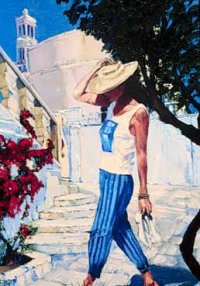One of the great Greek lyricists and few known female poets of the
ancient world, Sappho was born some time between 630 and 612 BC.
She was an aristocrat who married a prosperous merchant, and she had
a daughter named Cleis. Her wealth afforded her with the opportunity
to live her life as she chose, and he chose to spend it studying the
arts on the isle of Lesbos.
In the seventh century BC, Lesbos was a cultural center. Sappho spent
most her time on the island, though she also traveled widely
throughout Greece. She was exciled for a time because of political
activities in her family, and she spent this time in Sicily. By this
time she was known a poet, and the residents of Syracuse were so
honored by her visit that they erected a statue to her.
Her style was sensual and melodic; primarily songs of love, yearning,
and reflection. Most commonly the target of her affections was female
, often one of the many women sent to her for education in the arts.
She nurtured these women, wrote poems of love and adoration to them,
and when they eventually left the island to be married, she composed
their wedding songs. That Sappho’s poetry was not condemned in her
time for its homoerotic content (though it was disparaged by scholar
in later centuries) suggests that perhaps love between women was not
persecuted then a it has been in more recent times. Especially in the
last century, Sappho has become so synonymous with woman-love that two
of the most popular words to describe female homosexuality—lesbian and
sapphic have derived from her.
Text taken from: http://www.sappho.com/peotry/sappho.htm
